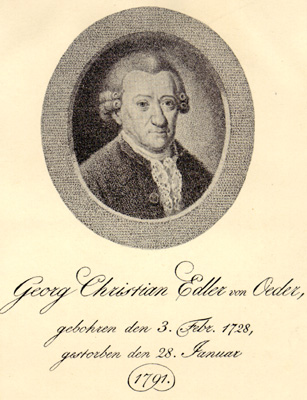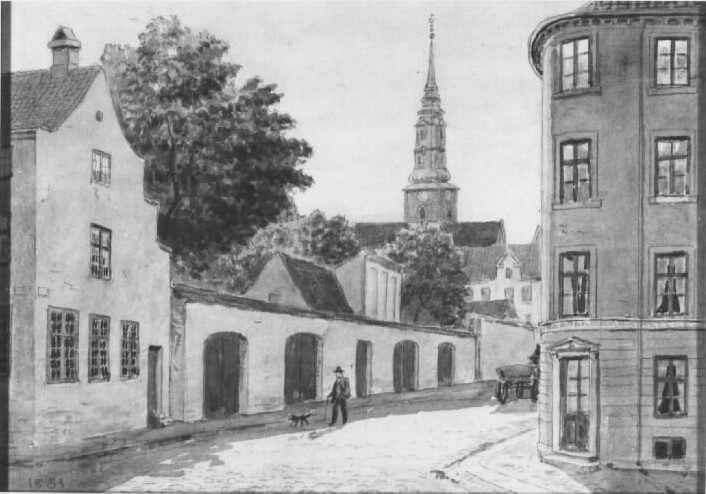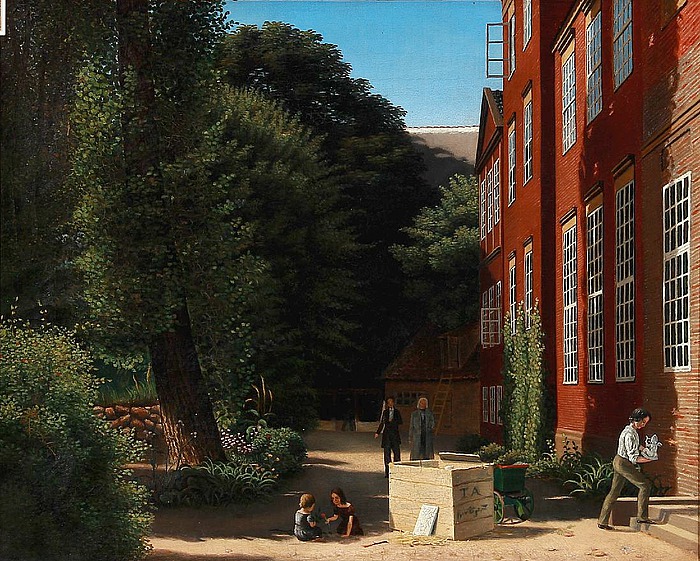University Of Copenhagen Botanical Garden on:
[Wikipedia]
[Google]
[Amazon]
The University of Copenhagen Botanical Garden ( da, Botanisk have), usually referred to simply as Copenhagen Botanical Garden, is a botanical garden located in the centre of Copenhagen, Denmark. It covers an area of 10 hectares and is particularly noted for its extensive complex of historical glasshouses dating from 1874.
The garden is part of the Natural History Museum of Denmark, which is itself part of the University of Copenhagen Faculty of Science. It serves both research, educational and recreational purposes.
The identification code of the ''University of Copenhagen Botanical Garden'' as a member of the
 The botanical garden was first established in 1600 but it was moved twice before it was ultimately given its current location in 1870. It was probably founded to secure a collection of Danish medicinal plants after the Reformation had seen many
The botanical garden was first established in 1600 but it was moved twice before it was ultimately given its current location in 1870. It was probably founded to secure a collection of Danish medicinal plants after the Reformation had seen many  The first garden, known as ''Hortus Medicus'', was created on 2 August 1600 by royal charter on a piece of land donated by the king,
The first garden, known as ''Hortus Medicus'', was created on 2 August 1600 by royal charter on a piece of land donated by the king,

 In 1778 both gardens were closed when the king reacquired the land at Amaliegade and at the same time donated a tract of land behind
In 1778 both gardens were closed when the king reacquired the land at Amaliegade and at the same time donated a tract of land behind
Official webpage
History and restoration
pdf about the garden
Source - Nyhavn
{{Authority control Botanical gardens in Denmark Parks in Copenhagen University of Copenhagen
Botanic Gardens Conservation International
Botanic Gardens Conservation International (BGCI) is a plant conservation charity based in Kew, Surrey, England. It is a membership organisation, working with 800 botanic gardens in 118 countries, whose combined work forms the world's largest plan ...
(BGCI), as well as the initials of its herbarium is C.Botanical Garden, Natural History Museum of DenmarkBotanic Gardens Conservation International
Botanic Gardens Conservation International (BGCI) is a plant conservation charity based in Kew, Surrey, England. It is a membership organisation, working with 800 botanic gardens in 118 countries, whose combined work forms the world's largest plan ...
History
The first garden: Hortus Medicus
 The botanical garden was first established in 1600 but it was moved twice before it was ultimately given its current location in 1870. It was probably founded to secure a collection of Danish medicinal plants after the Reformation had seen many
The botanical garden was first established in 1600 but it was moved twice before it was ultimately given its current location in 1870. It was probably founded to secure a collection of Danish medicinal plants after the Reformation had seen many convent
A convent is a community of monks, nuns, religious brothers or, sisters or priests. Alternatively, ''convent'' means the building used by the community. The word is particularly used in the Catholic Church, Lutheran churches, and the Anglican C ...
s and their gardens abandoned or demolished.
 The first garden, known as ''Hortus Medicus'', was created on 2 August 1600 by royal charter on a piece of land donated by the king,
The first garden, known as ''Hortus Medicus'', was created on 2 August 1600 by royal charter on a piece of land donated by the king, Christian IV
Christian IV (12 April 1577 – 28 February 1648) was King of Denmark and Norway and Duke of Holstein and Schleswig from 1588 until his death in 1648. His reign of 59 years, 330 days is the longest of Danish monarchs and Scandinavian mona ...
. It was located in Skidenstræde (now Krystalgade) and a residence for one of the professors of the university was also built at the site. It rested upon the professor in residence to maintain the garden, irrespective of which chair he held. In 1621 Ole Worm personally took over the responsibility for the garden and he enriched it with a great number of Danish medicinal plants as well as rare foreign species he received from his many professional contacts abroad.
Oeder's Garden
A second botanical garden was laid out byGeorg Christian Oeder
Georg Christian Edler von Oldenburg Oeder (3 February 172828 January 1791) was a German- Danish botanist, medical doctor, economist and social reformer. His name is particularly associated with the initiation of the plate work ''Flora Danica''. ...
in 1752 in the newly founded Frederiksstaden district at the request of Frederik V at a site bisected by Amaliegade just north of Frederik's Hospital. The smaller western section, covering just under half a hectare, was equipped with a greenhouse while the eastern section remained largely unplanted. The garden was opened to the public in 1763.
In 1770 part of Oeder's Garden was put at the disposal of the University's botanical garden. The preceding year Christian VII
Christian VII (29 January 1749 – 13 March 1808) was a monarch of the House of Oldenburg who was King of Denmark–Norway and Duke of Schleswig and Holstein from 1766 until his death in 1808. For his motto he chose: "''Gloria ex amore patriae'' ...
had donated 2,500 thaler to the University, the interest from which would be used for the Botanical Garden. This had created the economical foundation for an enlargement but since there was no space for it at its original address, the off-site solution was ultimately opted for.
Oeder became the Botanical Garden's first director. In order to emphasise its economic significance, as well as in the spirit of the Age of Enlightenment
The Age of Enlightenment or the Enlightenment; german: Aufklärung, "Enlightenment"; it, L'Illuminismo, "Enlightenment"; pl, Oświecenie, "Enlightenment"; pt, Iluminismo, "Enlightenment"; es, La Ilustración, "Enlightenment" was an intel ...
, he began a work in progress which was to become Flora Danica, an illustrated work describing all Danish and Norwegian plants. Oeder was fired in 1771 in connection with the Johann Friedrich Struensee
Lensgreve Johann Friedrich Struensee (5 August 1737 – 28 April 1772) was a German-Danish physician, philosopher and statesman. He became royal physician to the mentally ill King Christian VII of Denmark and a minister in the Danish government ...
affair.
The Charlottenborg Garden

 In 1778 both gardens were closed when the king reacquired the land at Amaliegade and at the same time donated a tract of land behind
In 1778 both gardens were closed when the king reacquired the land at Amaliegade and at the same time donated a tract of land behind Charlottenborg Palace
Charlottenborg Palace ( da, Charlottenborg Slot) is a large town mansion located on the corner of Kongens Nytorv and Nyhavn in Copenhagen, Denmark. Originally built as a residence for Ulrik Frederik Gyldenløve, it has served as the base of the Ro ...
for the establishment of a new and larger botanical garden. Plans for this garden received royal approval on 22 July 1778. It was to have two directors, one appointed by the University and the other by the King. The first University appointment to this post was Christian Friis Rottbøll, who had already managed the garden since Oeder's retirement, and the first royal appointment was Johan Theodor Holmskjold. At the same event, an associate professor was employed at the garden. The first to hold this chair was Martin Vahl, who played a large part in moving the plants from Oeder's Garden to Charlottenborg Garden.
In 1817, the model with a double directorship was abandoned when Jens Wilken Hornemann
Jens Wilken Hornemann (6 March 1770 – 30 July 1841) was a Danish botanist.
Biography
He was a lecturer at the University of Copenhagen Botanical Garden from 1801. After the death of Martin Vahl in 1804, the task of publishing the Flora Danica ...
was made the sole director of the garden. At this stage the garden encompassed approximately 1.6 hectares in a low, waterlogged area that was bounded by Charlottenborg, Nyhavn
Nyhavn (; New Harbour) is a 17th-century waterfront, canal and entertainment district in Copenhagen, Denmark. Stretching from Kongens Nytorv to the harbour front just south of the Royal Playhouse, it is lined by brightly coloured 17th and early ...
, the Mint and Bremerholm. A main building was erected along the Nyhavn canal, housing both a botanical museum, a library and residences for the director and a botanical gardener. There were also facilities for the storage of sensitive plants during winter. The garden's first greenhouse, ''Guiones Koldhus'' (''Guione's Coolhouse''), was erected in 1784. In 1803 the king funded of a new 200-square metre complex of greenhouses and nore were added in 1837.
In 1841 Joakim Frederik Schouw
Joakim Frederik Schouw (7 February 1789 – 28 April 1852) was a Danish lawyer, botanist and politician. From 1821, professor in botany at the University of Copenhagen — first extraordinary professor, but after the death of J.W. Hornemann in ...
replaced Hornemann as director and the garden. Among his initiatives was the establishment of a new section dedicated to Danish species, holding 570 species, and improved cataloguing of plants and seeds. His tenure lasted until 1852. During this phase the garden became still more cramped and it became evident that another expansion was needed.
The current garden
200px, Plan of the new Botanical Garden The botanical gardens got its current location in 1870. Four years later in 1874 the gardens got its large complex of glasshouses at the initiative ofCarlsberg Carlsberg may refer to:
Places
* Carlsberg (district), a district in Copenhagen, Denmark
** Carlsberg station, its train station
* Carlsberg, Germany, a municipality in Rhineland-Palatinate, Germany
* Carlsberg Fjord, Greenland Other uses
* Carl ...
founder J. C. Jacobsen
Jacob Christian Jacobsen (2 September 1811 – 30 April 1887), mostly known as J. C. Jacobsen, was a Danish industrialist and philanthropist best known for founding the brewery Carlsberg.
Biography
He had no formal academic or scientific traini ...
who also funded it. His inspiration was that of the glass building the Crystal Palace
Crystal Palace may refer to:
Places Canada
* Crystal Palace Complex (Dieppe), a former amusement park now a shopping complex in Dieppe, New Brunswick
* Crystal Palace Barracks, London, Ontario
* Crystal Palace (Montreal), an exhibition buildin ...
that was erected for the Great Exhibition in London in 1851.
In 1977 the gardens, including the greenhouses, became listed by Danish Agency for Culture and Palaces
The Danish Agency for Culture and Palaces ( da, Slots- og Kulturstyrelsen) is an agency under the aegis of the Danish Ministry of Culture. The agency carries out the cultural policies of the Danish government within the visual and performing arts, ...
, the Danish conservancy authorities.
Copenhagen Botanical Garden today
Copenhagen Botanical Garden is an informal garden with free admission. There are conservatories, a museum and herbarium, a library (admission by appointment only) ashop
Shop or shopping refers to:
Business and commerce
* A casual word for a commercial establishment or for a place of business
* Machine shop, a workshop for machining
*"In the shop", referring to a car being at an automotive repair shop
*A wood ...
plants, seeds and a small selection of garden equipment and eating place.
Collections
The botanical gardens contain more than 13,000species
In biology, a species is the basic unit of Taxonomy (biology), classification and a taxonomic rank of an organism, as well as a unit of biodiversity. A species is often defined as the largest group of organisms in which any two individuals of ...
. The garden is arranged in different sections including: Danish plants (600 species), perennial plants (1,100 species), annual plant
An annual plant is a plant that completes its life cycle, from germination to the production of seeds, within one growing season, and then dies. The length of growing seasons and period in which they take place vary according to geographical l ...
s (1,100 species), rock gardens with plants from mountainous areas in Central and Southern Europe and Conifer Hill which is planted with coniferous trees. One of the newest inclusions is a rhododendron
''Rhododendron'' (; from Ancient Greek ''rhódon'' "rose" and ''déndron'' "tree") is a very large genus of about 1,024 species of woody plants in the heath family (Ericaceae). They can be either evergreen or deciduous. Most species are nat ...
garden
The garden has many handsome specimen trees. The oldest tree in the gardens is a taxodium from 1806 that was moved along from the old location at an age of 60 years.
Glasshouses
The Gardens have 27 glasshouses. The most notable is the 3000-square metre conservatory complex from 1874. The Palm House at its centre is 16 metres tall and has narrow, cast-iron spiral stairs leading to a passageway at the top. Plants include a palm from 1824 and a fine collection ofcycad
Cycads are seed plants that typically have a stout and woody ( ligneous) trunk with a crown of large, hard, stiff, evergreen and (usually) pinnate leaves. The species are dioecious, that is, individual plants of a species are either male or ...
s, some of which are more than 100 years old. A fifty metres long glasshouse house an extensive collection of cacti
A cactus (, or less commonly, cactus) is a member of the plant family Cactaceae, a family comprising about 127 genera with some 1750 known species of the order Caryophyllales. The word ''cactus'' derives, through Latin, from the Ancient Gree ...
and other succulents whilst another one houses orchid
Orchids are plants that belong to the family Orchidaceae (), a diverse and widespread group of flowering plants with blooms that are often colourful and fragrant.
Along with the Asteraceae, they are one of the two largest families of flowering ...
s and begonias. A modern glasshouse is dedicated to caudiciforms. The garden also has a special air-conditioned greenhouse that can re-create environments suitable for Arctic plants.
The Palm House
Here is the list of some plant species growing at the Palm House:Museum and seed bank
The university's botanical museum and herbarium are housed in a building situated within the garden, giving the garden staff ready access to reference works and more than 2 million dried plant specimens.Surrounding buildings
Social Sciences Faculty Library
Located at 140 Gothersgade, the building was designed byJohan Daniel Herholdt
Johan Daniel Herholdt (13 August 1818 – 11 April 1902) was a Danish architect, professor and royal building inspector. He worked in the Historicist style and had a significant influence on Danish architecture during the second half of the 19th a ...
and built from 1888 to 1890 as botanical Laboratory. It is a Historicist building inspired by Italian palazzi, a style which Herholt had previously relied on in his now demolished National Bank at Holmens Kanal
Holmens Kanal is a short street in central Copenhagen. Part of the main thoroughfare of the city centre, it extends from Kongens Nytorv for one block to a junction with a statue of Niels Juel where it turns right towards Holmens Bro while the thro ...
. The building has housed the faculty library of the Faculty of Social Sciences since 2011.
Institute of Psychology
Institute of Psychology, at 2A Øster Farimagsgade, is based in a building which was built in 1957 to the design of Kai Gottlob for the Institute of Biology at University of Copenhagen.Public art, monuments and memorials
In 1909 to 1911,Carl Jacobsen
Carl Christian Hillman Jacobsen (2 March 1842 – 11 January 1914) was a Danish brewer, art collector and philanthropist. Though often preoccupied with his cultural interests, Jacobsen was a shrewd and visionary businessman and initiated the tra ...
installed a number of casts of classical statues in the garden.
See also
*Parks and open spaces in Copenhagen
Copenhagen is a green city well endowed with open spaces. It has an extensive and well-distributed system of parks that act as venues for a wide array of events and urban life. As a supplement to the regular parks, there are a number of congenial ...
References
External links
Official webpage
History and restoration
pdf about the garden
Source - Nyhavn
{{Authority control Botanical gardens in Denmark Parks in Copenhagen University of Copenhagen